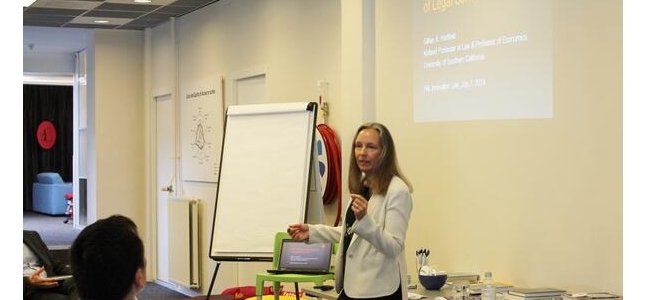The legal services market is highly inefficient, if not dysfunctional. Existing rules are keeping it that way. New insights into how this market works and the innovation potential that comes with the IT revolution are poised to change this. The first movers are taking their positions. It is difficult to imagine that things will stay as they are much longer.
These were some of the points that were discussed during HiiL’s Open Lab Session on Monday, July 7 with Gillian Hadfield. The audience included most of the key decision makers on legal innovation in The Netherlands.
In all so-called developed economies the demand for legal help is tremendous. We witness failure of access to justice. In the US, the amount of unrepresented people appearing in court keeps growing, courts face shrinking budgets and caseloads keep growing. The traditional answer has been legal aid and pro bono work, in various forms. This problem, however, can never be solved by legal aid and pro bono alone.
Gillian Hadfield does the math, based on US numbers (without there being a reason to assume that her general argument would change if European numbers were used). Assuming that the average hourly rate for legal services in the US is $200, the annual revenue of an average law firm (working full-time) would then be about $140,000. Out of that amount, around $25,000 goes for payrolls and nearly twice as much (say $45,000) goes for overhead, insurances and other administrative costs. Evidently, only half of the revenue is spent on actual legal work.
Where does the money go? The largest portion of legal fees are spent on finding and keeping clients; managing client complaints; investing in legal knowledge, technology and processes; running a business and perhaps more. Not on legal work. Roughly speaking, lawyers receive about 20% of the hourly rate they charge. If you are working to increase basic justice care for people, that is a highly dysfunctional market.
Why is this so? Gillian Hadfield is clear in her diagnosis: excessive regulation of the legal services market. Using the US as an example, she lists some of the restrictions imposed on legal practitioners: all legal work must be done by licensed lawyers; lawyers serving public can only work in firms entirely owned, managed and financed by lawyers; lawyers cannot enter profit- or revenue-sharing contracts that give non-law experts incentives to reduce cost and increase quality of non-law elements of legal services; legal innovators cannot access venture capital- just to name a few.
How can this be changed? Change the rules so lawyers can do law and others can do the non-law elements of legal services. This is where a gaping innovation space lies. There are already very interesting examples of first overs in this area:
- UpCounsel– an online attorney marketplace connecting start-ups and small businesses with legal help from independent attorneys which eliminates the extra time and extra costs law firms require. UpCounsel manages the brand, guarantees payment, etc. and the lawyers do the legal work.
- LegalZoom– an online legal service that helps people create their own legal documents related to forming and naming a business; legal forms and agreements; taxes, licenses and permits; trademarks; business compliances and many others.
- Which? – a charity funded platform for providing free legal advice. Members, as well as their families, are given individual jargon-free advice and step-by-step guidance to winning cases.
- Rechtwijzer 2.0 – a justice platform developed by HiiL, offering legal information and advice. It enables people to work on solving their legal problems in their own words, at their own pace, from their own homes with the support of professionals readily available to help them.
Where does the Netherlands stand? Participants in our open lab session agreed that the Dutch legal system has a competitive advantage over the US and UK at least in two major aspects:
- Much cheaper access to law
- No need for a license to practice law.
But is this enough to say that the Dutch legal system is ahead of the curve? Hardly. Moreover, if the current legal market model is so evidently broken, then why are RoL development providers selling it to countries in transition? These and many other questions are yet to be answered. Guided by Gillian Hadfield’s groundbreaking research, however, we have made the first step in addressing these issues- putting them on the map.


